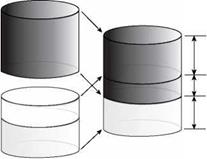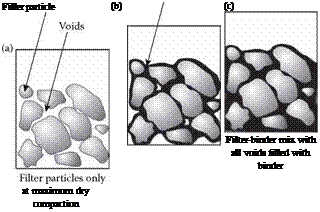Idea of Voids in Dry-Compacted Filler
Let us imagine a set of grains that are going to be dry-compacted by tamping.[13] The result will be a mixture with its volume consisting of grains and some free spaces among them. In a regular binder mortar (blend of filler and binder), these free spaces in a compacted filler would be occupied by binder. The rest of binder would remain as excess filler. Thus binder contained in a mortar can be divided into the following two types (Figure 3.2):
![]()





Bulk volume of compacted mineral filler
FIGURE 3.2 Free and fixed binder concept. (From Harris, B. M. and Stuart, K. D., Journal of the Association of Asphalt Paving Technologists, 64, 54-95, 1995; Kandhal, P. S., Journal of the Association of Asphalt Paving Technologists, 50, 150-210, 1981. With permission.)
• Fixed binder—binder inside the voids (filling the voids among compacted filler grains)
• Free binder—excess binder remaining after the voids have been filled
As in the comparison of two fillers with differing gradations, here we may demonstrate much the same tendencies—the same quantity of two fillers but with different contents of voids may bond differently to the amount of binder. Actually what really matters is the quantity of free binder, because the properties of the mastic are dependent on it. The lower the content of free binder in a mortar, the faster the growth of its stiffness (Harris and Stuart, 1995). The minimum amount of free binder has been defined in U. S. research, based on the modified Rigden method, as 30% (v/v) of an asphalt mortar (Anderson, 1987; Chen and Pen, 1998). With that level of free binder, filler grains are suspended in the binder and they do not touch each other. In addition, the rest of the mineral mixture (the coarse aggregate) will be coated by only the free binder, so it is important that a sufficient quantity is available.
Figure 3.3 illustrates the process of gradually filling the voids in a compacted filler; the binder essentially plays two roles—that of a lubricant making the relocation of grains easier and that of a liquid in which they can be suspended.[14]
 |
 |
With a constant content of binder in an asphalt mixture, the quantity of free binder depends on the voids in the compacted filler. With fixed proportions of components in an asphalt mix, the quantity of free binder can be increased by changing to a filler
FIGURE 3.3 Gradually filling the voids in a compacted filler. (From Anderson, D. A., Guidelines on the use of baghouse fines. National Asphalt Pavement Association. Information Series 101-111, 1987b; Harris, B. M. and Stuart, K. D. Journal of the Association of Asphalt Paving Technologists, 64, 54-95, 1995. With permission.)
with a lower void content. Obviously the reverse is also true. The final requirements for the void content in a compacted filler may be defined as follows:
• They cannot be too high—so as to prevent fixing the whole binder, or too much of it, and to leave enough binder for the rest of the asphalt mix— otherwise the mortar will be too dry, stiff, and susceptible to cracking and water damage
• They cannot be too low, because too much unbonded, excess binder will create a greater risk of mix instability, excessive bleeding and binder drain – down, and the deformability (rutting susceptibility) of an asphalt mixture
The following are the recommended contents of voids in a dry-compacted filler:
• When using results of Rigden’s method (test according to EN 1097-4), the minimum content of voids in a dry-compacted filler should amount to 28% (v/v) and the maximum content should not exceed 45% (v/v) (Schellenberger, 2002).
• When using results of Rigden’s method modified by Anderson (as in the United States) (test according to Anderson [1987]), the maximum content of voids in a dry-compacted filler should not exceed 50% (v/v) (Brown and Cooley, 1999).
The main factors that influence the content of voids in a dry-compacted filler are as follows (Kandhal, 1981):
• Particle size
• Particle shape
• Particle surface structure
• Particle size distribution
Examples of void contents in various dry-compacted fillers tested according to Rigden’s original method and specific areas according to Blaine’s method [Schellenberger, 2002] are as follows:
|
4750 cm2/g 3600 cm2/g 2280 cm2/g 2068 cm2/g 2658 cm2/g 4054 cm2/g |
Limestone (added filler) 27.7-31.6%
Diabase (baghouse fines) 30.4-34.2%
Limestone (baghouse fines) 28.3-32.1%
Dolomite (added filler) 27.1-28.1%
Dolerite-microdiabase (baghouse fines) 32.4-36.4% Greywacke (baghouse fines) 27.6-31.8%
The following are some sample results of void contents in various dry-compacted fillers according to Rigden’s method modified by Anderson (Schroer, 2006):
Mineral filler 39-47%
Baghouse fines 30-60%
Hydrated lime 66-71%
Fly-ash 37-57%
Generally, the results obtained from Rigden’s original method (as used in Europe) are slightly lower than the results from the modified Rigden method (as used in the United States). The reason is the difference in compactive effort. A similar test, which is an indirect usage of the Rigden voids concept, is the German Filler Test; this test shows good correlation to the modified Rigden method results (see Chapter 8).






Leave a reply